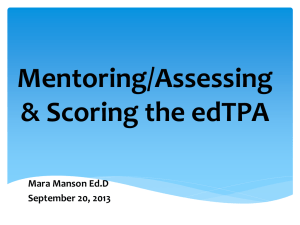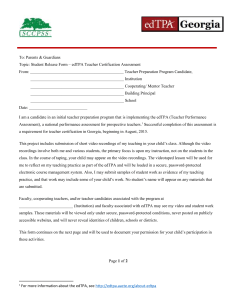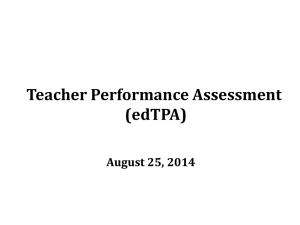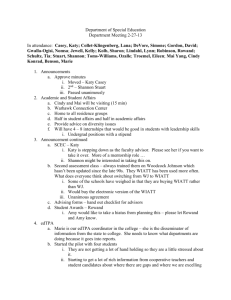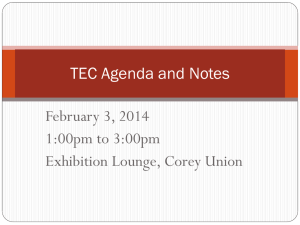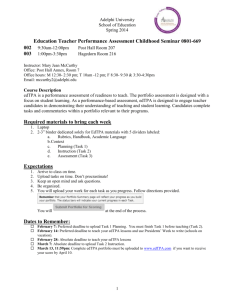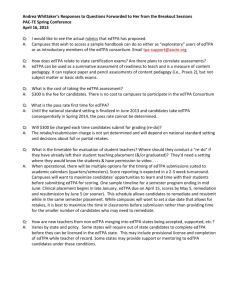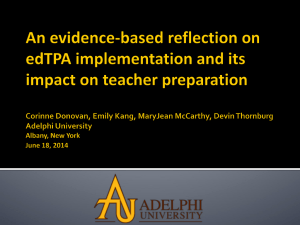edTPA presentation
advertisement
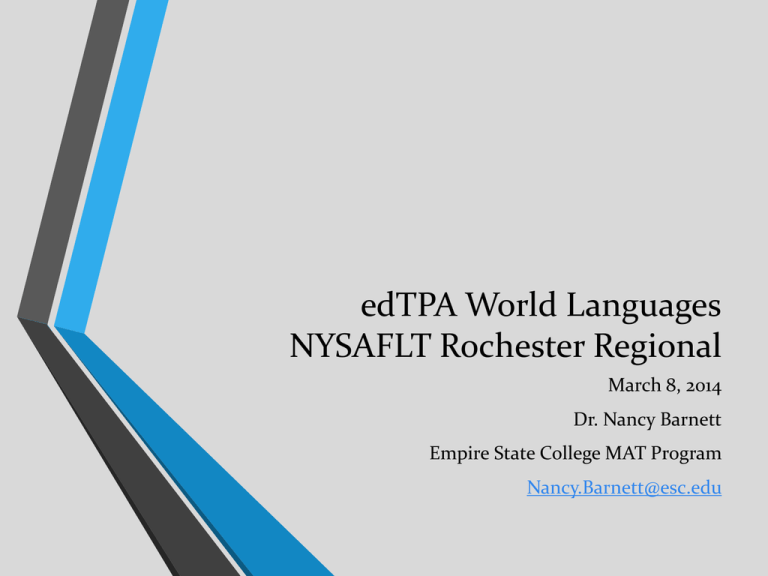
edTPA World Languages NYSAFLT Rochester Regional March 8, 2014 Dr. Nancy Barnett Empire State College MAT Program Nancy.Barnett@esc.edu What is edTPA? • A performance-based assessment to determine a novice teacher’s readiness to begin teaching • ed Teacher Performance Assessment • All content areas • Each tailored to key understandings/skills applicable to the discipline. Who should know about edTPA? • • • • • • Teachers in training Master/experienced teachers for work with future student teachers Department supervisors and administrators College level faculty of teacher training/methods/supervision Host teachers for student teachers Educators wanting to stay current in the field Development of edTPA • 25 years in development and field testing • Involvement of more than 1,000 educators in 29 states • Led by SCALE (Stanford Center for Assessment, Learning and Equity) • Extensive input from national content areas (e.g. ACTFL), AACTE (American Association of Colleges for Teacher Education), many others. Current national status of edTPA • 34+ states participating • Phasing in or pilot phase in several other states • 7+ states currently using edTPA for certification • In New York State, it now is consequential in that it is required for initial teaching certification (after April, 2014). Features of edTPA • An electronic portfolio that contains a specific set of sequenced evidence of a novice teacher’s skills • Three categories of Planning, Instruction, and Assessment • Teacher’s commentary with rationale for choices and analysis of his/her performance in each of these areas. • Focus on teacher becoming reflective in practice. Handbook Resource • Handbook for each content area • World Language (42 pages) - printing it out is recommended (all or key parts) • Read thoroughly – best starting point • Guidelines included for all parts, format expectations, technical requirements, etc. • Glossary of terms edTPA World Languages • Aligned with New York State LOTE Standards • Aligned with National LOTE Standards (5 Cs – Communication, Cultures, Connections, Comparisons, Communities) • Integration of educational initiatives ; e.g. Common Core Standards, extending higher order levels of thinking, literacy development. Communicative proficiency Central focus – developing communicative proficiency in the target language in meaningful cultural context. 3 modes of communication: Interpretive Interpersonal Presentational Recommended: Begin to articulate all LOTE instruction as it promotes communicative proficiency, with all learning tasks linked to the mode(s) of communication addressed. Components of WL edTPA Portfolio • • • • • • A learning segment of 3- 5 lessons Context for learning (description of school, program, learners, IEPs, etc.) Detailed plans for 3 lessons Unedited video clips (15 minutes in one or two samples) of teacher/student interaction Assessments for the learning segment Commentary for each component Planning considerations • See rubrics 1,2,3,4 • Assure that plans are well sequenced, build on each other, align with standards, develop communicative proficiency in meaningful cultural context • Evidence of plans for use of target language • Instructional materials • Commentary Instruction considerations • See rubrics 5,6,7,8,9 • Video clips (15 minutes in one or two segments unedited) • Use of target language • Permission required • Commentary analysis (self-assessment) and next steps • Recommended: begin to practice taping Assessment considerations • See rubrics 10,11,12,13 • Whole class plus three focus students in detail • Commentary critical • Evidence of analysis: what learned from assessment and how it informs next steps in instruction. Scoring considerations • • • • • • National scorers – Content specialists experienced in both LOTE teaching and working with novice teachers Required training and qualification testing Monitored for inter-rater reliability and accuracy in scoring Approximately 2.0 – 3.0 hours to score portfolio In depth review of all artifacts as they relate to rubrics Extensive use of rubrics, highlighting of evidence, scores must link scores to evidence in artifacts General rubric levels 1 Struggling, not yet ready to teach 2 Developing skills, but not ready to teach 3 Has skills to begin teaching 4 Well prepared to begin teaching 5 Highly accomplished beginner Additional information and resources • • • • • • Academic language component and rubrics (in other content areas, not World Languages) Input from faculty can be general (e.g. review of rubrics), but not specific Cut scores Timeline of reasonable deadlines Lesson plan templates – many available (LOTE specific) Video presentations (e.g. Linda Darling-Hammond) Steps to begin edTPA portfolio • • • • Recommended: print Handbook, extra copy of 13 rubrics and glossary of terms. Use an edTPA LOTE lesson template for planning Be reflective in teaching. College faculty: engage students in frequent reflection and linking of instruction to theory. Inform host teachers of edTPA. Justify all instruction in terms of how it promotes communicative proficiency. Identify Interpretive, Interpersonal, Presentational communication. Final suggestion • Don’t panic! • See edTPA as an opportunity to demonstrate what you have learned and how you apply learning to the LOTE classroom.

